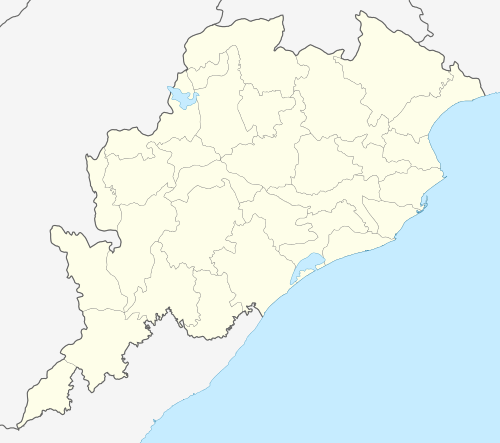Chandaka Elephant Sanctuary
| Chandaka Elephant Sanctuary | |
|---|---|
|
Chandaka Forest and Elephant Reserve | |
| Location |
 Chandaka Elephant Sanctuary (Odisha) |
| Nearest city | Bhubaneswar |
| Coordinates | 20°21′N 85°40′E / 20.350°N 85.667°ECoordinates: 20°21′N 85°40′E / 20.350°N 85.667°E |
| Area | 175.79 square kilometres (67.87 sq mi). |
| Established | 1982 |
| Governing body | Divisional Forest Officer, Chandaka[1] |
Chandka Elephant Sanctuary is a wildlife reserve located in north western fringe of Bhubaneswar in the Indian state of Odisha. Nestled on Khurdha uplands of 'Eastern Ghats' biotic region, Chandaka forest spread over 175.79 square kilometres (67.87 sq mi) of rolling table land and small sprawling hillocks of Khurdha and Cuttack Districts. It was designated as an elephant reserve in December 1982.
Flora
Floral diversity is distributed in 6 types, viz., secondary moist miscellaneous semi-evergreen forests, moist Kangada (Xylia xylocarpa) forests, Coastal Sal forests (Shorea robusta), thorny bamboo brakes (Bambusa bambos), planted Teak and Eupatorium scrub. Main tree species are Kochila, Kalicha, Belo, Kangada, Giringa, Sunari, Sal, Kumbhi, Jamu, Karanja, Teak and Sidha. Male bamboo (Dendrocalamus strictus) has a very restricted distribution. Common medicinal plants of the sanctuary are Duramari, Baidanka (Mucuna pruriens), Brudhadaraka, Bhuinlimbo, Guluchi lata, Salparni (Desmodium gangeticum), Satabari, Bhuin-kakharu, Indrajaba, Thalkudi, Apamaranga, Kurchi, Patalgaruda etc. A few species of ground Orchids, Ferns, Club mosses, Bryophytes and Lichens are distributed in shady wet pockets and rock escarpments.
Fauna

| Wikimedia Commons has media related to Deras Dam. |
Indian elephant is the flagship species and indicative of the potential productivity of the habitat.[2][3] Leopard is in the apex of biological pyramid. Chital, barking deer, mouse deer, wild pig, common langur, rhesus monkey, small Indian civet, common Indian mongoose, small Indian mongoose, ruddy mongoose, pangolin, sloth bear, ratel, Indian wolf and hyena are other mammals of the area. Chital or spotted deers are commonly encountered in groups of 3-7 on forest roads, forest openings, grass lands, foreshore of water bodies and even near guard camps. Wild dogs are occasionally seen. And after 40 long years researchers have found evidence of a tigress & her cub in the forest, recently in the winters of 2012, they have spotted footprints of those two magnificent creatures.
Prominent birds of the sanctuary are peafowl, red junglefowl, crested serpent eagle, great horned owl, black headed oriole, paradise flycatcher, coucal and stone curlew. Kumarkhunti reservoir, during winter, serve as transient roosting and feeding ground for several migratory duck species, notably, garganey and common teal, pintail, spot billed and Brahminy duck and white eyed pochard. Lesser whistling teal, dabehick, cotton teal, nakta, lesser cormorant, bronze winged jacana, white breasted waterhen, pied, white breasted and little blue kingfishers and red wattled lapwings are other resident birds around. In July the reservoir transform into an abode of migratory birds, mainly, open billed storks, pond heron, egrets and cormorants. Butterflies are abundant during monsoon and post monsoon months.
Among reptiles, rock python and Bengal monitor lizard are quite common. Chameleon, common skink, Indian flap shell turtle, Russell's viper, bamboo pit viper, common krait, common vine snake, kukri snake, Indian bronze back are indicative reptiles. Mugger crocodiles have remarkably adapted to large water bodies after their release.
The wonderful bird life of the sanctuary is no less significant. Kumarkhunti reservoir, in winter, serves as transient roosting and feeding ground for several migratory duck species, notably, garganey and common teal, pintail, spot billed and Brahminy duck and white eyed pochard. Lesser whistling teal, dabehick, cotton teal, nakta, lesser cormorant, bronze winged jacana, white breasted waterhen, pied, white breasted and little blue kingfishers and red wattled lapwings are other resident birds around. In July the reservoir transform into an abode of migratory birds, mainly, open billed storks, pond heron, egrets and cormorants. Butterflies are abundant during monsoon and post monsoon months.
The Zoological Survey of India (in 2002) has reported 37 species of mammals, 167 species of birds, 33 species of reptiles, 13 species of amphibians and 28 species of fishes in this sanctuary.[4]
Watch towers
For visitors there are a number of watch towers to observe wild life. While Kochilaberana, Pitagadia and Charichhak watch towers are excellent for observation of birds and animals, the ones at Kumarkhunti and Ambilo have the comfort of rest houses where one can make a night halt.
There are two water reservoirs - Deras Dam and Jhumka Dam, situated within the reserve. The cottages near Deras provide a scenic view of the Chandaka reserve and a chance to see wildlife.
References
- ↑ "Chandaka eco-tourism project stuck in land transfer". The Times of India. 30 April 2015.
- ↑ "Pachyderm Census to Begin from May 25". The New Indian Express. 27 April 2015.
- ↑ "80-year-old elephant dies in Orissa reserve". TopNews. 15 November 2009.
- ↑ Vertebrate Fauna of Chandaka Dampara Wildlife Sanctuary Odisha
External links
| Wikimedia Commons has media related to Elephant reserves of India. |
Gallery
- Security Checkpoint
- Nightlife details
- Mahout & tamed Pachyderm
- Natural Waterhole